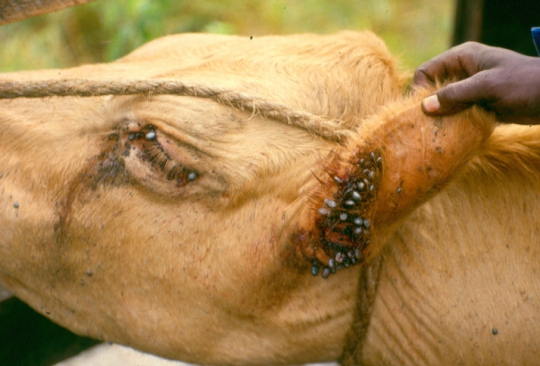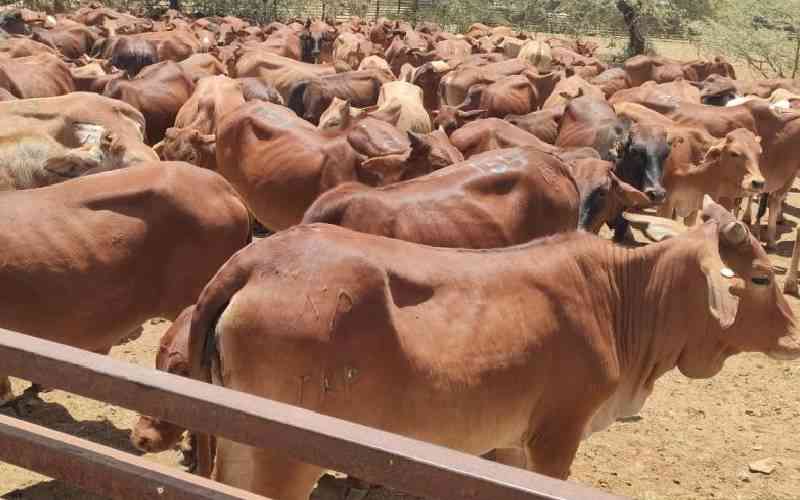
Every farmer is aware of the negative impacts of ticks on livestock, health, productivity and value.
Ticks bite, suck blood (which is their only food) and in the process spread disease causing microorganisms among them viruses, protozoa, spirochete and rickettsia which subsequently multiply and result in fatal illnesses.
Main economic losses caused by tick infestation result from reduced production, cost of treatment and reduced value of skin and hide.
Small as some may appear ticks are voracious blood feeders and heavy tick infestation can have depriving consequences on their hosts slowing down growth rate, wasting and reduced milk production in dairy herds.
Ticks exhibit a variety of host-contact patterns that are defined by their life cycles. One host tick species will spend all their life stages namely larva, nymph and adult on a single host’s body; two host and three host will use two and three host animals respectively to complete their life cycle.
It is important to know this as it not only informs the control strategies but also the disease spreading dynamics of various ticks.
Exotic animals are more prone to tick borne diseases compared to indigenous cattle and every care should be taken to protect them from ticks especially where indigenous herds are kept alongside exotic animal. In such settings ticks can easily spread infections across the breeds.
How are ticks spread?
Ticks normally wait for their hosts to pass by so that they can cling onto them any walk upwards to their preferred sites, attach and suck blood.
How are ticks controlled?
Various control methods and strategies are used in the control of ticks. They aim to prevent contact between ticks and to remove or kill ticks in contact with livestock.
Tick proof buildings
This approach is used especially where exotic high value animals are kept and involves the construction of tick proof housing. Cracks on walls and floor are used by ticks as hiding and breeding places.
Building housing structures devoid of cracks and crevices makes such structures unconducive for ticks greatly reducing infestation. An Acaricide tunnel around the housing can further minimise livestock tick contact by creating a barrier around the structure.
Stay informed. Subscribe to our newsletter
Quarantine
Animals introduced into a farm must be quarantined for sometime as they are sprayed with acaricides to kill all stages of ticks carried by the animal before they are mixed with the resident stock.
Manual removal
This method is applied where the number of infestation is low and animals are few. To remove the whole tick and with minimal disturbance to the animal, hold the tick close to the animal’s body and twisted anti-clockwise.
The removed ticks are then killed by burning. This method though enjoyable to the animal; posses the risk of human being getting in contact with deadly pathogens like the Crimean Congo Hemorrhagic Fever virus.
Dipping or spraying with acaricides
Acaricides can be applied either by dipping (in cattle dips), washes (by hand), spraying (by knapsack sprayers), pour-on, spot-on or by injections.
Dipping is a costly operation and is only desirable when a large number of cattle are involved or where a tick eradication programme is in place.
The frequency of dipping depends upon the species of the tick present in an area in order for the cycle to be effectively broken.
Hiding sites that may escape the dip or the wash? There are preferred sites for certain tick species on body parts of the animal which are not effectively treated by dipping or spraying. The inner parts of the ear, areas between teats, the tail bush, are offer hiding sites for certain tick species and may not be reached by the acaricide.
Hand dressing
These sites need special attention from the farmer. The selective application of acaricide to these sites is known as — hand dressing.
It is normally done as a supplement after dipping.
The acaricide is applied with a cloth, sponge, or even a hand spray, and either standard dip fluids are used, or an acaricide in an oily or greasy medium is used. Hand dressing can also be practiced by the owners on individual animals to control ticks which occur in small numbers.
Dipping precautions
Dips should be roofed to avoid concentration or dilution of the dip through evaporation of dilution by rain respectively.
Always dip animals in the morning to minimise livestock from drinking the dip (animals to be dipped shouldn’t be thirsty) and also for the acaricides to perpetrate better. Do not dip young, tired or injured animals.
Dung lowers the concentration of dip and its level should be continuously monitored. After swimming through the dip wash; let the animals drain properly before they go out to pasture fields, to minimise chances of the insecticide polluting the feed, fodder, or other items.
The dip must have a good design that allows the excess acaricide to safely drain back into the dip wash area. Take Precaution and wear protective clothing
People handling acaricides and assisting in either dipping, washing or spraying must wear masks, cloves, gumboots and apron to protect themselves from poisoning. Inhalation or skin contact with acaricides must be minimised. Don’t smoke or eat during this exercise and thourougly wash your hands with soap after handling acaricides. You may need to have an antidote (atropine sulphate injection) nearby to treat acaricide poisoning.
The writer is a veterinary surgeon working with the Kenya Tsetse and Trypanosomiasis Eradication Council (KENTTEC)
 The Standard Group Plc is a
multi-media organization with investments in media platforms spanning newspaper
print operations, television, radio broadcasting, digital and online services. The
Standard Group is recognized as a leading multi-media house in Kenya with a key
influence in matters of national and international interest.
The Standard Group Plc is a
multi-media organization with investments in media platforms spanning newspaper
print operations, television, radio broadcasting, digital and online services. The
Standard Group is recognized as a leading multi-media house in Kenya with a key
influence in matters of national and international interest.
 The Standard Group Plc is a
multi-media organization with investments in media platforms spanning newspaper
print operations, television, radio broadcasting, digital and online services. The
Standard Group is recognized as a leading multi-media house in Kenya with a key
influence in matters of national and international interest.
The Standard Group Plc is a
multi-media organization with investments in media platforms spanning newspaper
print operations, television, radio broadcasting, digital and online services. The
Standard Group is recognized as a leading multi-media house in Kenya with a key
influence in matters of national and international interest.










